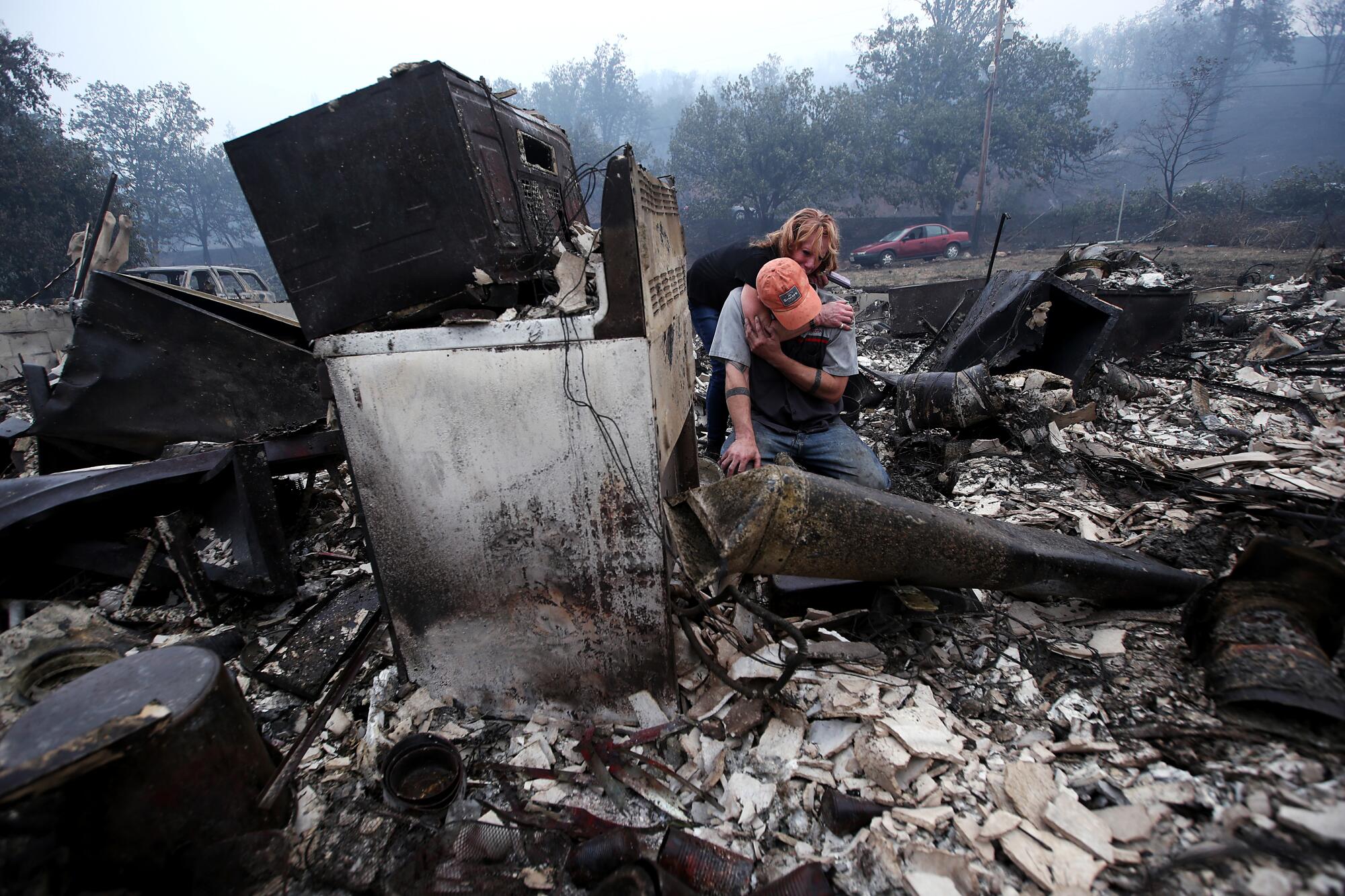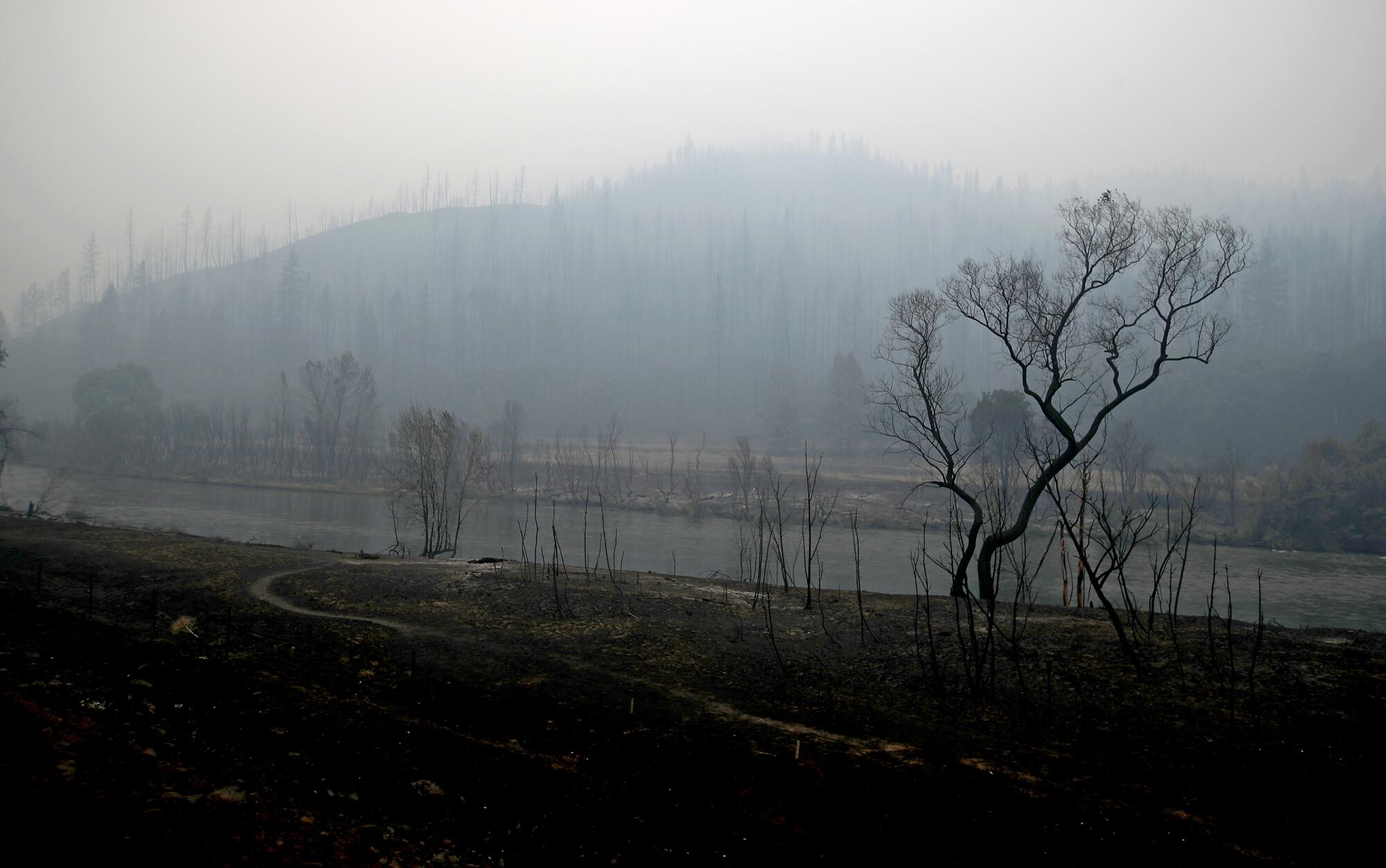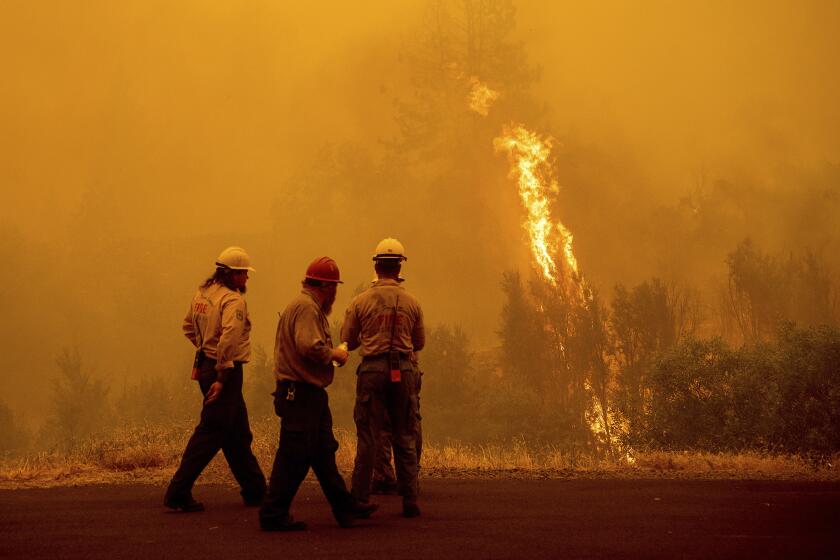
YREKA, Calif. — It was the perfect storm of factors for a deadly wildfire, experts say — extreme heat, dense and dry vegetation, and erratic winds and lightning brought on by persistent thunderstorms.
As the 55,000-acre McKinney fire continued to burn in steep and difficult terrain in Klamath National Forest on Monday, emergency crews encountered increasingly grim evidence of the wildfire’s extraordinary and explosive growth. At the same time, thunderstorms continued to inject unpredictability into the firefighting operations.

“It makes things very scary out there,” said Brian Nieuwenhuis, a meteorologist with the National Weather Service in Medford, Ore.
The bodies of at least two people who were attempting to flee the fire were discovered Sunday inside a vehicle in a driveway west of Klamath River, while an anthropology team from Chico State has been summoned to determine whether additional remains found Monday belonged to humans or animals, according to the Siskiyou County Sheriff’s Department.
The hikers were rescued on the California side of the trail at Red Buttes Wilderness as the McKinney fire continues to ravage Klamath National Forest.
Cadaver dogs and forensic specialists are also likely to help comb through devastated Northern California communities in the coming days, according to state emergency officials.

Residents who fled the fire said they were stunned by how quickly it moved.
“It happened so fast,” said Sherri Marchetti-Perrault. “We left with the clothes on our back. We couldn’t breathe and we couldn’t see.”
She said her home off Highway 96 had already begun to burn when her 78-year-old uncle refused to evacuate. After visiting the destroyed house on Monday, she said she feared her uncle was dead.

“I know where he was sitting and I saw him,” she said. “I’m sure it was him.”
More than 100 buildings are presumed destroyed, but the exact number remains unknown, as heat and flames have forced some assessment teams to retreat as fires have re-ignited. Officials warn also that nearly 5,000 structures remain threatened by the blaze and 3,000 residents have been ordered to evacuate. Another 3,000 residents have been placed under an evacuation warning that stretches to the Oregon border.
Though the fire’s spread had slowed slightly by Monday, storms continued to bedevil firefighters. There were 193 lightning strikes recorded in Siskiyou County over the preceding 48 hours, Nieuwenhuis said. The risk of thunderstorms was expected to last until Tuesday night.
Even as some rain helped limit the fire’s growth overnight, the lightning continued to ignite new fires. At least a dozen holdover fires were detected in the Klamath National Forest, ranging in size from less than one-tenth of an acre to several acres, the U.S. Forest Service said Monday.
In addition, firefighters were battling the 1,989-acre China 2 fire west of Seiad Valley and the 140-acre Alex fire above Doggett Creek, officials said.

Thunderstorms can generate gusty winds that blow in different directions, which Nieuwenhuis likened to blowing on a campfire. That can strengthen the updraft created by a large fire, which in turn can cause even more thunderstorms to develop, he said.
Why was the Oak fire so much more destructive than the Washburn fire? Experts say it’s because of weather, terrain and forest management.
On Monday afternoon, a hot drizzle fell over the Weed Community Center, where nearly all of the 157 cots assembled by the Red Cross had been occupied by evacuees.
Many feared the worst, but for Harlene Schwander, 81, it had already happened: Her house, located along Highway 96, was leveled by the fire.
“If I had known, I would have gotten more,” Schwander said. “I would have taken my sunglasses! I wasn’t thinking.”
Schwander, who is an artist, said she had almost nothing left save for the clothes on her back and the handful of family photos she grabbed before she fled on Saturday with her three Cavalier King Charles spaniels. Among the items lost to the fire were original paintings, photographs from her childhood and an antique rocking horse that, according to family lore, Richard Nixon rode on as a baby. Her daughter, who lives nearby, managed to save a trunk full of jewelry.

“I’ll be naked but laden with jewels,” Schwander joked. Despite her good humor, she wasn’t really sure what she would do next. She lives on Social Security — about $700 a month — and said she hadn’t been able to afford insurance on her home.
It was an all too familiar story for some residents of Siskiyou County, to whom fire is no stranger. Weed Mayor Kim Greene said much of the area was rebuilt after the Boles fire tore through in 2014, and many residents still had vivid memories of that blaze.
“What the people in Weed who have lost and rebuilt will tell you — this is the new normal,” she said.
An increase in catastrophic wildfires has reduced California tree cover by 6.7% since 1985, and researchers fear the lost trees will never grow back.
The McKinney fire started Friday afternoon amid a record-breaking heat wave and quickly spread through dense, drought-stressed timber, and was fanned by erratic winds from thunderstorms that moved through the area overnight. Lightning was ruled out as the cause of the fire, which remains under investigation, according to the Forest Service.
“The main factors of fire behavior are the fuels, the weather and the topography,” said Jeffrey Kane, professor of fire ecology and fuels management at Cal Poly Humboldt. All aligned to drive the explosive growth, he said.
The fire began in steep terrain in an area that hadn’t burned in about 100 years and had a history of commercial logging, which caused larger, more fire-resistant trees to be replaced by a denser concentration of younger trees that can sustain more severe, faster-moving crown fires, he said.
Research has shown that vegetation in the Klamath bioregion has grown denser due to government fire suppression policies and the displacement of Indigenous people who performed cultural burning. The Six Rivers National Forest to the south of where the fire began supports three times the number of trees it did in the 1880s, enhancing the ability of fire to spread across the landscape, said Clarke Knight, a postdoctoral researcher with the U.S. Geological Survey.

“Native stewardship was keeping this forest at much lower levels of biomass, or carbon,” she said. “To do that, they were actively putting fire on this landscape for at least 1,000 years.”
Although the McKinney fire was burning to the north of Karuk ancestral lands, it destroyed a building in Oak Knoll that housed the tribe’s archives and was threatening tribal housing and businesses in Yreka, said Bill Tripp, director of natural resources and environmental policy for the Karuk Tribe Department of Natural Resources.
The fire’s rapid spread did not surprise him, but he regarded it with frustration. Had the Karuk and other tribes been able to continue setting low-intensity fires to stimulate the production of foods, fibers and medicines, the fuels in the area would be less connected, and it’s unlikely fires like the McKinney would burn so severely, he said.
“You can really change the way fire moves across a landscape and behaves and potentially confine it if you’re doing those cultural-type burns at the appropriate scale,” he added.
An increase in catastrophic wildfires has reduced California tree cover by 6.7% since 1985, and researchers fear the lost trees will never grow back.
Northern California had an extremely dry winter that stood out even in the midst of an unprecedented drought, Kane said. In addition, the fire was preceded by a string of days with triple-digit temperatures and low humidity, which dried out finer fuels and gave them little opportunity to recover moisture at nighttime, he said.
Large fires tend to coincide with severe heat waves, which are taking place more frequently because of climate change, said Park Williams, a climate and wildfire scientist in the geography department at UCLA.
“Because the globe is warming and because heat waves tend to be more severe when the land is dry, the dice are loaded toward severe heat waves,” he said. “And when severe heat waves do occur over dry forest areas, then they can translate into gigantic, fast-moving wildfires.”
Evacuee Leland Erickson, 60, a military historian and trained intelligence analyst, said he put the odds of his property surviving at 80%. He manages his 13-unit building, and had taken time to do some brush clearance around the perimeter.
But it was clear that even he was on edge — especially since there was little he could do but sit around and wait, constantly scanning for fire updates and information on his phone.

“I’ve had a lot of hard knocks in my life, so I am mentally preparing myself” for the worst, Erickson said. Before he left home, he packed his car to the brim with belongings, but he couldn’t grab everything. He worried that if the fire did reach his home, he would lose precious mementos of his beloved wife, Sandra, who died in 2020, as well as the model airplanes and figurines he’s been building for the better part of 40 years.
“What can I do at this point? I took what I needed to. I did triage, and I made hard choices,” he said. “We are refugees from a natural disaster.”
Times staff writers Richard Winton and Gregory Yee contributed to this report.
More to Read
Sign up for Essential California
The most important California stories and recommendations in your inbox every morning.
You may occasionally receive promotional content from the Los Angeles Times.















